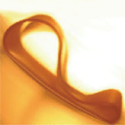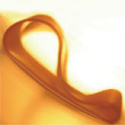Why a rolling rubber band squashes
The faster a rubber band rolls down an incline, the more squashed its shape. In a paper appearing in Physical Review Letters, Pascal Raux, Pedro Reis, and John Bush at MIT in the US and Christophe Clanet at École Polytechnique in France have now explained this shape progression in detail with experiments and an analytical theory. The shapes result from the interplay between bending forces, gravity, and inertia, and appear similar to rolling liquid drops, tumbling red blood cells, and carbon nanotubes deformed by van der Waals forces.
The team made 46-mm-diameter “ribbon” loops from polymers with a variety of material properties and using molds with different widths and thicknesses. Rather than a ramp, they placed the loops in a rotating steel drum, where they could control the speed and observe the ribbons’ steady, rolling shapes. In all cases, the loop became more deformed with increasing rotation speed until, at a critical speed, the upper and lower surface came into contact.
The team’s theory predicted the shapes of both static and rotating loops to high accuracy. Both gravity and rotation tend to squash the loop, whereas higher stiffness in the loop tends to resist the squashing. The group also accounted for the stretching of the loop material due to centrifugal force.
The authors note the similarity of the loop shapes with those of rolling liquid drops and red blood cells and propose that future investigations may find some common underlying principles among these systems. – David Ehrenstein





